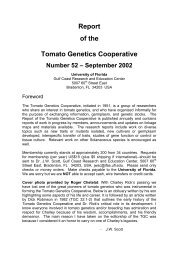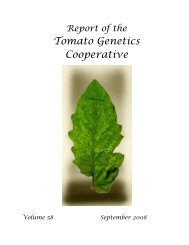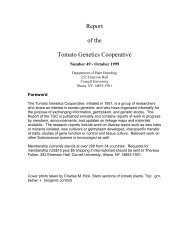Volume 60 - Tomato Genetics Cooperative - University of Florida
Volume 60 - Tomato Genetics Cooperative - University of Florida
Volume 60 - Tomato Genetics Cooperative - University of Florida
You also want an ePaper? Increase the reach of your titles
YUMPU automatically turns print PDFs into web optimized ePapers that Google loves.
63. Mew T.W., Ho W.C., 1977. Effect <strong>of</strong> soil temperature on resistance <strong>of</strong> tomato<br />
cultivars to bacterial wilt. Phytopathology 67: 909-911.<br />
64. Mohamed M.El.S., Umaharan P., Phelps R.H., 1997. Genetic nature <strong>of</strong> bacterial wilt<br />
resistance in tomato (Lycopersicon esculentum Mill.) accession LA 1421. Euphytica<br />
96: 323-326.<br />
65. Mohanakumaran N., Gilbert J.C., Young R.L., 1967. Bacterial wilt resistant tomato<br />
lines with unusually high content <strong>of</strong> the alkaloid tomatin. Rept. <strong>Tomato</strong> Genet. Coop.<br />
17: 41.<br />
66. Nakaho K., Inoue H., Takayama T., Miyagawa H., 2004. Distribution and<br />
multiplication <strong>of</strong> Ralstonia solanacearum in tomato plants with resistance derived<br />
from different origins. J. Gen. Plant Pathol. 70: 115-119.<br />
67. Opena R.T., Hartman G.L., Chen J.T., Yang C.H. 1992. Breeding for bacterial wilt<br />
resistance in tropical tomato. p.44-50 in: Proceedings <strong>of</strong> the 3 rd international<br />
conference on plant protection in the tropics. Malayasian Plant Protection Society,<br />
Kuala Lumpur.<br />
68. Opena R.T., Green S.K., Talekar N.S., Chen J.T., 1989. Genetic improvement <strong>of</strong><br />
tomato adaptability to the tropics: progress and future prospects. Pp 71-85 In:<br />
<strong>Tomato</strong> and Pepper Production in the Tropics. Proceedings <strong>of</strong> the International<br />
Symposium on Integrated Management Practices, S.K. Green (Sc. Ed.), T.D. Griggs<br />
& B.T. Mc Lean (Publ. Eds), AVRDC, Shanhua, Taiwan.<br />
69. Panthee, D and Gardner R.G. 2010. Identification <strong>of</strong> useful sources <strong>of</strong> bacterial wilt<br />
resistance in tomato: A challenge. Proc. 25th Annual <strong>Tomato</strong> Disease Workshop. P.<br />
18[Abstr.]<br />
70. Peter, K. V., Gopalakrishnan, T. R., Rajan, S., and Sadhan Kumar, P. G. 1993.<br />
Breeding for resistance to bacterial wilt in tomato, eggplant and pepper. p.183-190 in<br />
Bacterial wilt. ACIAR proceedings No. 45, edited by G. L. Hartman and A. C.<br />
Hayward. ACIAR, Canberra.<br />
71. Prior P., Grimault V., Schmit J., 1994. Resistance to bacterial wilt (Pseudomonas<br />
solanacearum) in tomato: present status and prospects. In: Bacterial Wilt, the<br />
disease and its causative agent Pseudomonas solanacearum, A.C. Hayward & G.L.<br />
Hartman (eds.), Wallingford (UK), CAB International : 209-223.<br />
72. Roque A., 1935. Annual Report <strong>of</strong> the Assistant Pathologist (wilt disease <strong>of</strong><br />
tomatoes). Puerto Rico Univ. Agr. Expt. Sta., Ann. Rpt. (1934-1935): 31-33.<br />
73. Rouamba A., Laterrot H., Moretti A., 1988. A case <strong>of</strong> relation between resistances to<br />
Pseudomonas solanacearum and Verticillum pathotype 2. Rept. <strong>Tomato</strong> Genet.<br />
Coop. 38: p.43.<br />
74. Schmidt R., 1936. <strong>Tomato</strong> breeding. N.C. Agri. Expt. Sta. Ann. Rep. 59: 68.<br />
75. Schmidt R., 1937. <strong>Tomato</strong> breeding. N.C. Agri. Expt. Sta. Ann. Rep. <strong>60</strong>: 55-56.<br />
76. Scott, J.W. 1997. <strong>Tomato</strong> improvement for bacterial disease resistance for the<br />
tropics: A contemporary basis and future prospects. In: Proc. First International<br />
Conference on Processing <strong>Tomato</strong>/First International Symposium on Tropical<br />
<strong>Tomato</strong> Diseases, Recife, Brazil, ASHS Press, Alexandria, VA USA. p. 117-123.<br />
77. Scott, J.W., Jones J.B., 1986. Sources <strong>of</strong> resistance to bacterial spot (Xanthomonas<br />
campestris pv. vesicatoria (Doidge) Dye) in tomato. HortScience 21(2):304-306.<br />
27





